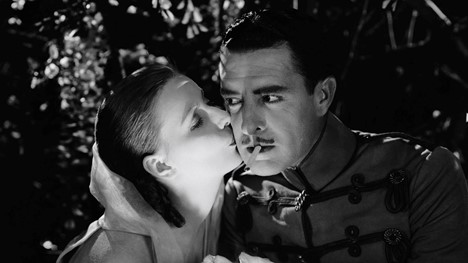Flesh and the Devil (1926)
Clarence Brown's "Flesh and the Devil"
After her success in the German film industry, Greta Garbo moved to California to star in Hollywood films. One of her first major breakthroughs was 1926's "Flesh and the Devil." The film was directed by Clarence Brown, who had been a mainstay Hollywood director since he took the reigns of 1920's "The Last of the Mohicans." "Flesh and the Devil" was Garbo's first collaboration with Brown - a collaboration that would continue for numerous films to come. The film made Garbo an international star, catapulting her to the top of Hollywood's A list.
The film centers on two friends, Leo and Ulrich, who take leave from their posts in the German army. During their leave, Leo falls in love with Felicitas, the wife of a powerful count. The count catches the two of them in an affair and challenges Leo to a duel. Leo kills the Count, hoping that he and Felicitas can finally be together. However, Leo is sent to a military outpost in Africa for three years. When he returns, he finds that Ulrich has married Felicitas. Behind Ulrich's back, Leo and Felicitas express their desire to reunite and run away together. At the last minute, Felicitas backs out and Leo attacks her. Ulrich walks in to find this scene and challenges Leo to a duel. The next day, the two back out of the duel and rekindle their friendship. Meanwhile, Felicitas rushes to their aid and falls into an icy lake, and dies.
The main attraction of the film is the sexual tension between Leo and Felicitas. Throughout, the two are never actually 'supposed' to be together. In the beginning, Felicitas is married to the count. After Leo returns from Africa, she is married to Ulrich. The sexual desires of the two characters are elevated by the boundaries that separate them. Audiences feel palpable sexual frustration throughout the film.
An impressive element of the production is Brown's direction and William H. Daniels' cinematography. Despite this being a film released in 1926, one would think it was released in the early 1930s (purely on a visual level). Brown does a good job of being efficient with his camera, yet creative. He doesn't overstretch any visual abundance. His precision with visual efficiency allows the viewer to forget about the direction altogether. He uses close-ups in moments of intimacy, an unchained forward-moving camera to illustrate fear or dread, and wide shots to illustrate setting. For creative flourishes, there are scenes that use superimposition to illustrate subjective perspective, point-of-view shots to establish a viewpoint, and montage editing to express abstract ideas to contextualize scenes. Meanwhile, cinematographer Daniels creates a visual crispness to the image. This crispness is unlike many films at the time, both in Hollywood and internationally. The visuals are clear, light is used properly, and dimensions are expressed subtly. Daniels's cinematography was so impressive that Greta Garbo insisted that Daniels be her prime cinematographer moving forward.
The film not only catapulted Garbo to Hollywood stardom but also ignited a Hollywood romance. The romantic affiliation between the film's characters Leo and Felicitas was made even more palpable by the real-life romantic relationship between the two actors who played them. John Gilbert, who played Leo, began a romance with Garbo before the production started. They had even moved in together by the time production of the film was completed. Their romance was widely known and became a hot topic in the Hollywood scene. The couple went on to make numerous other films together until Gilbert's career ended when the sound era ended.
The film marked the beginning of not only Garbo's Hollywood stardom but also a collaboration between her and Brown that would last the next decade. Brown's actualization of romantic chemistry and sexual tension would be the foundation of his films to come.




Comments
Post a Comment